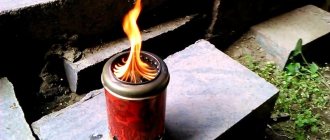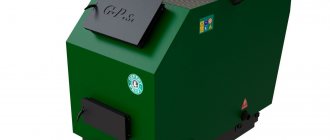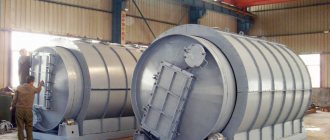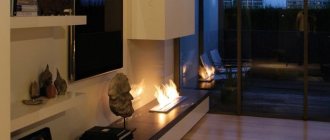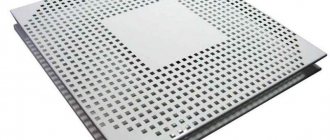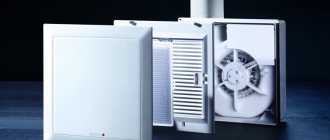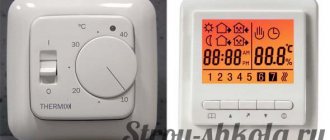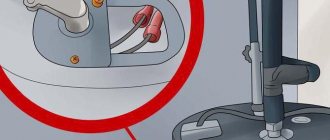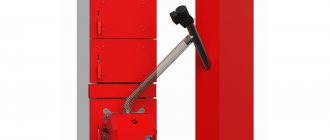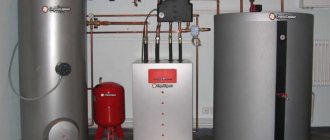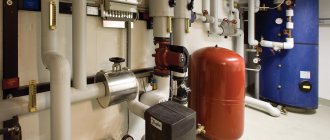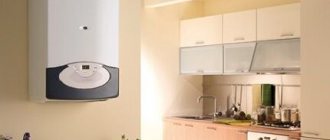What's happened?
In addition to waste incineration, there is waste pyrolysis technology. This term was formed from two Latin words, and literally means “decomposition by fire.” The technology allows you to recycle all types of household waste.
Pyrolysis occurs at very high temperatures and without oxygen. This thermal effect allows you to break down mixed waste. The result is simple substances:
- gas,
- resin,
- water solution,
- solid sediment.
Pyrolysis plant for processing solid waste
Solid sludge contains the mineral part of the waste. Pyrolysis products can be used as fuel.
What is pyrolysis, how is it used in boilers?
So, pyrolysis
– this is the decomposition of hydrocarbon raw materials under high temperature conditions with a lack of oxygen. Applicable to firewood or coal, pyrolysis is the decomposition of solid fuel into flammable gases and dry residue (ash, slag). Pyrolysis of wood and coal occurs at temperatures from 300 to 500 degrees. This is the temperature regime that allows flammable gases to be released from the binder, leaving only a dry residue in the feedstock in the form of wood ash or coal slag. In the natural environment, pyrolysis of solid fuel occurs along with the combustion of the released gases. In industrial pyrolysis plants, this process occurs with a lack of oxygen, or its complete absence (to prevent direct combustion of decomposing fuel). The resulting flammable gases in industrial installations are removed from the pyrolysis chamber for subsequent use for technological needs. You can read more about the pyrolysis of petroleum products in the online encyclopedia WikiPedia
The only use of pyrolysis gases produced as a result of thermal decomposition of fuel is the production of thermal energy released as a result of the thermochemical reaction of combustion of a mixture of pyrolysis gases with air.
The chemical composition of pyrolysis gases includes carbon monoxide (CO), hydrogen (H), methane (CH4), nitrogen (H) and carbon dioxide (CO2). In this chemical cocktail, only carbon monoxide, hydrogen and methane are flammable substances that enter into a thermochemical reaction at temperatures of 800-900 degrees Celsius. Nitrogen is an inert gas that does not enter into thermochemical reactions with other substances at temperatures up to 2000 degrees Celsius. Carbon dioxide is the end product of thermochemical reactions during the combustion of carbon monoxide, therefore this compound, like nitrogen, is useless in the composition of pyrolysis gases.
In industrial installations, pyrolysis of solid fuel occurs in closed chambers with a complete lack of oxygen access. Biomass heating is provided from an external heat source. In order for the installation to be self-sufficient, most often this external heat source is supplied with part of the resulting pyrolysis gases to obtain thermal energy from the fuel that is subjected to pyrolysis. You can see an example of the design of such installations in the image below:
In industrial pyrolysis boilers, the process of pyrolysis decomposition of fuel does not occur with a complete lack of access to oxygen, due to the lack of the possibility of heating the fuel from an external source. In pyrolysis boilers, the pyrolysis process is supported by minimal combustion of the resulting pyrolysis gases directly in the fuel decomposition chamber. The thermal energy of this process is directed to the decomposition of the entire mass of fuel loaded into the furnace. In this case, most of the resulting pyrolysis gases are discharged into a separate chamber, where they are burned as deeply as possible to obtain the maximum amount of thermal energy.
There are two main types of pyrolysis industrial boiler designs on the market. In the industrial sector of this equipment, the design with an upper combustion chamber for pyrolysis gases is leading. We will devote the main part of our today's research to this design, but before we talk in more detail about these boilers, we would like to go back a little and share the history of the appearance of pyrolysis plants.
According to information that we were able to obtain from open sources, the first pyrolysis plants began to be mass-produced back in the 30s of the 20th century. During the time of Stalin's industrial growth, the development of the country and its natural resources. This period is characterized by the presence of mass-produced vehicles powered by internal combustion engines. Production growth, exploration of new territories, and development of mineral extraction occurred against the background of a low level of production of petroleum products, which are raw materials in the production of fuel for internal combustion engines. This imbalance in the supply and demand of fuel for cars led to the birth of wood-burning gas generator units. The gases produced in such installations were used in cars and even in light aircraft as an alternative fuel. In modern realities, this experience and knowledge have found application in boiler equipment for domestic and industrial use. Now let's talk about industrial boilers of the most popular design presented on the domestic market.
Kinds
An important factor in the course of pyrolysis is temperature. Depending on the temperature, complete or partial decomposition of the components of mixed waste occurs. Pyrolysis is divided into two types, depending on how high the temperature of exposure to the waste is.
Low temperature
Low-temperature pyrolysis is the process of decomposition at temperatures up to 900 degrees. The operating temperature is about 450 degrees.
Low-temperature pyrolysis produces a large amount of solid fuel – charcoal – from waste.
In this case, little pyrolysis gas and resin are formed.
Low-temperature pyrolysis scheme
With this method, heavy metals are not smelted, but fall into a solid sediment that must be buried at a landfill.
Low-temperature pyrolysis allows you to reduce the volume of waste several times. They become less hazardous to the environment. Pyrolysis products can be used as fuel.
High temperature
High-temperature pyrolysis occurs at temperatures above 900 degrees. The waste also breaks down into gas, pyrolysis oil and semi-coke.
High-temperature pyrolysis can produce more gas and less solid and liquid residues from waste.
The purity of pyrolysis gas obtained at high temperatures is comparable to natural gas. Heavy metals can be separated from ash when using this technology.
High temperature pyrolysis scheme
Only small wastes are suitable for high-temperature pyrolysis. In order to start the process, mixed waste must be sorted into large and small fractions. After sorting, large fractions are crushed and also loaded into the installation.
The low-temperature pyrolysis method is used for already sorted waste. It is not suitable for mixed waste that contains dioxins. For pyrolysis at low temperatures, the raw materials must also be dried.
Installations for the high-temperature method are demanding only in terms of the size of the feedstock. Drying occurs directly in the reactor, and the output is a residue free of dioxins and heavy metals.
Types of pyrolysis
There are several different options for the procedure depending on the methods used for processing primary products. The table below provides descriptions.
| Name | Characteristic |
| Dry | Used when solid waste needs to be processed. Among the advantages of the methodology is saving resources and money during the processing process. A large amount of raw material for combustion is not required. |
| Oxidative | Intended for liquid and gaseous substances. It is based on the process of oxidation and decomposition of substances into simple components. Most effective for recycling liquid plastic, oil, natural gas and other environmentally hazardous substances. The methodology is completely safe for nature and health. |
| Low temperature | It involves the decomposition of the components of the main product when exposed to low temperatures - up to 900 degrees. This results in a fairly large amount of solid residue. Gas is also produced in some quantity, which can be used for industrial purposes. |
| High temperature | This implies maintaining high temperatures during the combustion process. Ensures thorough processing of primary raw materials. Among the advantages are the production of large amounts of gaseous substances, as well as the reduction of solid waste. Doesn't require much disposal. Resources will be required to maintain one temperature regime. |
| Fast | It goes by quite quickly. The process can be compared in speed to boiling water. It happens instantly. Thermal energy quickly moves from one state to another. |
| Slow | Differs from what is described above in a reduced reaction rate. Requires a long time and significant resources. Suitable for those cases where efficiency is not important. |
Each of the options is actively used in practice and has its own scope. Technologies for their implementation are constantly evolving.
Advantages and disadvantages
The technology is not new, and humanity has successfully used it at all stages of its development.
Pyrolysis, as such, was used in Russia back in the 12th century to smelt resin from wood.
Pyrolysis for waste treatment began to be used relatively recently. However, humanity began to produce garbage on a huge scale also recently.
This high-tech method of waste processing has many advantages, but it also has disadvantages.
Pros of pyrolysis:
- When recycling waste, the air is not polluted. There are no harmful emissions, which are often more dangerous than the original raw materials.
- Pyrolysis plants are safe for nearby populated areas. Moreover, they can become a source of energy for small villages.
- The raw material for pyrolysis is municipal solid waste from landfills. This technology allows you to recycle even car tires and organic raw materials.
- Pyrolysis products are useful substances that can be used as fuel. These substances are used in pyrolysis plants for their autonomous operation. Companies sell excess fuel.
- The sediment (ash) remaining as a result of pyrolysis can be buried without harm to the environment. Ash after high-temperature pyrolysis is used in construction because it does not contain unoxidized carbon.
Disadvantages of pyrolysis:
- With low-temperature pyrolysis, dioxins do not completely decompose, and heavy metals are not melted.
- Pyrolysis plants are expensive and difficult to maintain.
- Low temperature installations require a large number of workers.
Pros and cons of burning
Garbage pyrolysis is a procedure for neutralizing waste by exposing it to high temperatures. It involves burning hazardous objects using specialized installations.
dina.ykt
energolesprom
waste.recycling
ivgrun_cg
energolesprom
To carry out this task, certain conditions must be met: limiting the access of oxygen to the sealed chamber, as well as creating a high temperature regime inside. During this process, products are broken down at the molecular level. The result is simpler compounds that are completely safe for nature.
Advantages and disadvantages of the technology:
- decomposition products are not released into the environment, which avoids the spread of harmful substances;
- complete safety for human health;
- raw materials are available to everyone and are inexpensive, they can be found almost anywhere where people live;
- landfills have a large amount of resources to burn;
- it is possible to process those types of waste deposits that are not amenable to other methods of destruction;
- no hazardous substances are formed during the decomposition process;
- pyrolysis products can be buried without harm to nature;
- reducing the volume of processed material several times;
- heavy and hazardous metals are completely converted into ash, which eliminates the possibility of their further spread.
- high cost of equipment and installation work;
- complexity of system management;
- a large number of employees are required to control the process.
All the disadvantages of pyrolysis are associated with the resources necessary for its implementation. Large costs are required to ensure continuous recycling, which not all enterprises can afford.
MSW pyrolysis products
The raw material for pyrolysis, as mentioned above, is mixed garbage. Transported to landfills, this garbage lies compressed without access to air. In such conditions, even food waste, paper and cardboard do not decompose. A landfill can catch fire because methane is released when waste decomposes without access to air. This gas is flammable, and if the landfill gets too hot, it can ignite.
The products of landfill combustion are toxic and hazardous to the environment.
Pyrolysis, on the contrary, is a useful technology. As a result of pyrolysis, a sufficient amount of useful materials can be obtained from mixed hazardous waste:
- Synthetic oil is a liquid fraction. It is formed as a result of the pyrolysis of plastics and tires. This is natural, because these materials are made from oil. Synthetic oil resembles natural oil. It can be used in its pure form as fuel for boiler houses and thermal power plants, or processed into motor oil.
- Semi-coke is a solid fraction. It ignites easily, burns well and produces about 31-35 MJ/kg when burned. Semi-coke is used in all areas where high-calorie fuel is needed.
- Pyrolysis gas is a gaseous fraction. This gas has properties similar to natural gas and can be used to generate heat or electricity.
Synthetic oil in a bottle
In addition, pyrolysis itself releases a large amount of energy, which is used to maintain the operation of the plant.
Pyrolysis products
As a result of processing the following products are obtained:
- carbon – 30 – 40%
- pyrolysis oil – the percentage depends on the weight of the loaded waste and averages 20 – 65%
- metal cord – formed as a result of modification of tires and tires
- mixture of pyrolysis flammable gases – 10%
The waste conversion process also releases small amounts of water and steam. All pyrolysis products find their application in many industrial fields.
Ground carbon is used in the manufacture of dyes and rubber. In this case, waste tires are used for recycling.
Pyrolysis oil is converted into gasoline or diesel fuel through distillation.
Design and principle of operation of a pyrolysis plant
The pyrolysis plant is a block mobile structure.
The basis of the pyrolysis installation is a sorting belt, a loading block, a volumetric chamber for waste, a reactor, a welding shaft, and heating devices.
During the pyrolysis process, condensers, coolers, gas analyzers, and chimneys come into operation. There are also containers for collecting useful fractions - liquid and gaseous - and an unloading module.
There are installations that can operate continuously. There are also those that need time to cool down after the processing cycle. It is more economical to have a continuous cycle plant that operates without downtime.
How does the installation work?
Before pyrolysis begins, the waste must be sorted. Waste of non-ferrous and ferrous metals, plastic, glass, in a word, that which can be recycled, is removed from the total mass. For this purpose, special sorting lines are equipped at pyrolysis waste processing plants.
Before being sent to the pyrolysis plant, solid waste is sorted into large and bulk waste. Bulk waste is loaded into the compartment without prior preparation, and large waste is crushed into smaller parts.
After all the waste is inside, the installation heats up to 400 degrees. The hottest part is the middle part of the installation - there the temperature reaches 900 degrees and the pyrolysis reaction takes place. The temperature is much lower at the top, where the raw materials dry out and are cooked.
Pyrolysis products are collected using condensers and coolers. Thus, the gas is cleared of oils. The solid residue automatically enters the storage chamber. Workers remove it from there.
The design of a pyrolysis plant in computer graphics can be seen in the video, which also shows the types of waste processed and the technological process itself:
Since 2015, the production and trading company, part of the group of companies of the Technoservice industrial holding, has been dynamically developing the direction of processing (disposal) of industrial waste using the method of thermal decomposition (low-temperature pyrolysis up to 600°C) and the production of pyrolysis equipment "T-PU1", which has a positive State Environmental Expertise (received in 2016 for 10 years). Our company produces and sells T-PU1 installations and pyrolysis technology for the processing, neutralization and disposal of carbon-containing industrial waste of hazard class 3-5, including: rubber waste, including used tires; fuel oil; waste from oil and gas production; oils; rubber; oil and oil products sludge; coal; waste solvents and paints and varnishes; medical waste; cleaning materials and clothing contaminated with oils; polyethylene containers and films; railway sleepers; roofing felt; coke masses; contaminated "tails" of solid waste, etc. In the process of pyrolysis processing (recycling) of waste, commercial products are obtained in the form of liquid furnace (pyrolysis) fuel, burnt metal (steel cord, shavings, cable, foil, etc.), carbon, paraffin, and the generated pyrolysis gas is sent to operate the equipment.
In 2021, PTK Pyroliz-Ekoprom LLC was included by the Russian Ministry of Industry and Trade in the list of Russian enterprises producing domestic import-substituting equipment operated in the case of the use of the best available technologies (BAT).
Low-temperature pyrolysis method - decomposition of organic waste during gradual heating in the temperature range of 0-600 ° C (depending on the waste) in the absence of oxygen and contact of waste with open fire, resulting in the decomposition of waste into liquid and gaseous products, ash residues, which have minimal impact harmful impact on the environment (below MPC).
Waste recycling by low-temperature pyrolysis (up to 600°C) at T-PU1 installations is a promising and highly profitable production with the opportunity to receive not only payment for waste disposal, but also allows you to additionally obtain pyrolysis (furnace) fuel and other commercial products from waste processing products. Pyrolysis equipment “T-PU1” consumes only 1.1 kW of electricity and operates using its own pyrolysis gas generated during the processing process. Due to the receipt of recycling payments and the sale of commercial products obtained as a result of waste processing, the profitability of production (waste processing) on the pyrolysis of some types of waste can be more than 500% (!!!), which makes this technology much more economically attractive than the more expensive high-temperature (up to 1200°C) pyrolysis without obtaining fuel and commercial products, which involves contact (burning) of waste with an open fire.
Pyrolysis installations “T-PU1” are more modern modernized installations, in the development of which the specialists of our design bureau took into account a number of inconveniences and negative operating practices of pyrolysis equipment models presented on the market. The technology and design of the T-PU1 installations, before launching them into mass production in 2021, were tested over four years of operation of six installations in our own pyrolysis workshop (Nizhny Novgorod region, industrial zone of Kstovo) on more than a hundred types of various industrial wastes.
Detailed video presentation of the T-PU1 pyrolysis installations and the waste disposal process in the pyrolysis workshop of PTK Pyroliz-Ekoprom LLC (in the video there are old models of retorts and a retort tipper, new modernized models are being produced in 2021):
Pyrolysis technology makes it possible to process mixed types of waste, including those containing water, contaminated with oil products, sand, rust, metals, etc. Recently, pyrolysis equipment has begun to be used in solid waste landfills for recycling and obtaining fuel from “tails” - contaminated waste polyethylene, PET, films, rubber, etc., which cannot be sorted and sold on the secondary market. Manufacturers of crumb rubber from tires, through pyrolysis, solve the problem of processing their illiquid waste (contaminated steel cord, synthetic cord, tire scraps) into marketable products, and at the same time have the opportunity to accept used tires for neutralization/recycling, since, unlike pyrolysis, recycling tires into crumbs does not constitute their recycling with the possibility of receiving recycling payments.
In the process of processing most types of waste, marketable products are obtained in the form of pyrolysis (furnace) fuel (up to 80%) and carbonized residue (commercial carbon black or slag of the 5th hazard class). When tires are pyrolyzed, an additional commercial product is obtained: burnt metal cord, which is easily pressed and sold on the market. When pyrolyzing petroleum waste together with fuel, the commercial product paraffin is additionally obtained. The volume of output of heating oil and carbon residue after pyrolysis depends on the type and composition of the waste being processed. Oil-containing waste, sludge, oils are the most profitable types of raw materials during processing (disposal) of which up to 80% of heating oil and even higher can be obtained (using waste oil - up to 90%). On rubber and tires, the yield of heating oil is up to 50%, on polyethylene and film – up to 30%. When pyrolyzing certain types of waste (peat, polyethylene film, etc.) using a line of several T-PU1 units, a large volume of excess pyrolysis gas can be obtained, which can be generated into electricity through a gas holder and a gas generator.
A distinctive feature of the heating oil sold by PTK Pyroliz-Ekoprom, produced in the T-PU1 pyrolysis units, is its high combustion rates and low sulfur content, which makes this fuel more competitively attractive in the heating oil market of a similar price category. Without additional processing, our heating oil can be used for combustion: in industrial furnaces and boilers; heat generators equipped with atomizing burners, as well as for heating non-gasified facilities, private houses, garages, ensuring the operation of asphalt plants, drying units used in the agricultural sector, etc. After processing, carbon black is used in many industries, including the production of fuel briquettes, dyes, filter fillers, and is used in metallurgy.
The advantages of T-PU1 installations are their low cost compared to analogues while using higher quality and more expensive materials in the production of furnaces and retorts, compactness, ease of operation and maintenance.
An important parameter for T-PU1 installations is the sanitary protection zone of only 100 meters approved in the State Environmental Expertise for equipment.
Pyrolysis plants "T-PU1" have excellent emissions of harmful substances, such as dioxins, the level of which is lower than those established by the relevant legislation.
Since August 2021, we, in cooperation with a defense industry enterprise that manufactures containers for the petrochemical and nuclear industries, have launched into mass production a fundamentally new model of a retort of an exclusive design, with an internal volume of 2.58 cubic meters, made of 8 mm chromium-nickel titanium-containing stainless steel grade 12Х18Н10Т (or analogue), which has higher strength and is more resistant to oxidation of combustion elements at high temperatures.
Since 2021, a new modification of the retort with a reinforced SEAMLESS bottom, 10 mm thick, has been launched into mass production.
The spherical bottom and lid of the retort are made by hot stamping by hydraulic extrusion from a sheet of metal using a press. This design of the bottom significantly reduces the likelihood of its deformation (pulling). The design of the retort makes it possible, during new brewings, to rotate the main body of the retort relative to the lid at angles of multiples of 90 degrees, which significantly reduces the thermal load on the bottom due to periodic displacement/rotation of the heating zone relative to the flame of the furnace burner.
This exclusive design of the retort not only allows you to achieve maximum tightness, but also significantly reduces the likelihood of thermal deformation of the retort body, significantly increasing its service life and reducing operating costs, since lower-quality “budget” retorts can burn out and are often subject to repair (including including replacing the bottom).
Unlike analogues, the T-PU1 installations have a more optimal retort size (reduced height and increased diameter), which provides better and faster heating of raw materials throughout the entire volume, which leads to a reduction in heating (cooking) time with better pyrolysis. Reducing the height of the retort (installation) makes it easier to maintain, allows the use of a room with lower ceilings and simpler loading mechanisms (even a loader). Since the height of unequipped T-PU1 stoves is 2.6 m, they can be transported vertically by a standard Eurotruck and require fewer vehicles for transportation compared to more “bulky” analogues.
The retort diameter of 1400 mm allows you to load raw materials in “big bags” or plastic Eurocubes into the retort without overloading!!!
AN IMPORTANT ADVANTAGE of the T-PU1 installations is the presence of a combustion chamber for igniting the furnace (starting heating of the furnace until pyrolysis gas appears) with solid fuel (for example, old pallets/wood waste or own fuel briquettes from carbon residue), which is almost 10 times more economical ( !!!) compared to ignition with liquid fuel and saves about 500,000 rubles per year compared to similar pyrolysis installations with ignition by a liquid fuel burner, which consume up to 7 kW/h of electricity and up to 50 liters of fuel for the initial heating of the furnace (with low waste gasification even more). At the request of customers, additional installation of a liquid fuel burner is possible in T-PU1 installations.
In the T-PU1 installations, unlike other similar pyrolysis installations, an equipment module has been developed and installed - “Water cut-off device” , which significantly reduces the “coking” of pipes in the cooling system. This innovative development allows for several times less frequent maintenance (cleaning) of equipment tubular lines.
The optimality and compactness of the pipeline circuits and components in the T-PU1 installation allow 1-2 times a month (depending on the type of waste, the amount of resins, etc.) to easily clean (do preventive maintenance) the equipment by blowing hot for 2-3 hours steam from a steam generator instead of labor-intensive mechanical and manual cleaning.
Depending on the operating conditions, it is possible to use different cooling systems, including containers with circulating water. The internal walls of the furnace in T-PU1 units are lined with more expensive, durable fireclay bricks, which retain more heat and reduce costs.
The productivity of one T-PU1 installation with a retort of 2.58 cubic meters will be up to 8 cubic meters of waste per day (depending on the loading density, type of waste, cycle time and the number of retorts used). The operation of the T-PU1 installations is cyclical. In round-the-clock operation, on average, three cycles of operation (cooking) are obtained per day when using two retorts. On some types of “loose” waste, four cycles are obtained using three retorts. One operator and one/two auxiliary workers can service the operation of 3-4 T-PU1 units.
The cost of a standard set of one T-PU1 installation with one retort is 2,950,000 rubles, including VAT.
To increase the overall production productivity, “T-PU1” installations can be combined (added “as a constructor”) into a production line. For example, a technological line (module) of 8 T-PU1 units has a capacity of up to 35 tons of oil sludge or up to 60 cubic meters of solid waste per day when serviced by 4 people.
The modularity of installations has a number of additional advantages, since with a production line consisting of several installations, in the event of any breakdown (even cleaning or maintenance) of one of the installations, it is not necessary to stop the entire production, as in the case of using pyrolysis equipment in the form of a single bulky “monoblock”. If it is necessary to transfer the T-PU1 installation to another site, the equipment can be dismantled/installed quickly and without any particular difficulties.
The “T-PU1” option is the most popular due to its low cost, compactness, mobility, ease of operation and maintenance, maintainability, minimum electronics and electricity, and the ability to use mixed raw materials with virtually no preparation and drying.
If the volumes of waste (raw materials) allow, then it is economically feasible to use the installations in pairs, launching them according to the pendulum principle. In this case, excess pyrolysis gas from one installation is directed in antiphase to the starting heating of another installation and vice versa, which minimizes afterburning of excess gas and starting heating of the furnace with other fuel.
Using a large number of T-PU1 installations, our company, in cooperation with the Faskhimmash plant, has developed a gas holder installation for collecting pyrolysis gas and distributing it to any pyrolysis installation, which in turn allows the introduction of a more automated pyrolysis control process and significantly facilitates the work of operators , minimizes the starting heating of installations with other types of fuel and eliminates flaring of excess pyrolysis gas. In the case of a remaining pyrolysis gas in excess of the required volume for heating the installations, the excess pyrolysis gas, thanks to the gas holder, can be subsequently used to generate heat or electricity.
The use of a retort tipper (there are two versions available - electric or mechanical) facilitates the work of unloading ash and non-combustible residue from the retorts. The tipper is an optional additional equipment; it can be used to simultaneously operate a line of several T-PU1 units.
The T-PU1 equipment can be installed in an open area (depending on the climate zone). A special foundation for the equipment is not required - a hard surface (concrete slab) is sufficient.
Structurally, the T-PU1 installations are less bulky than their analogues, which allows, if necessary, to dismantle/install the equipment quickly and without any particular difficulties and transport the T-PU1 installations to another site.
Despite the above advantages, a more advanced retort model and higher quality materials of the T-PU1 pyrolysis plants compared to analogues, the cost of the T-PU1 plants is lower than analogues of comparative productivity, since the primary goal of our enterprise is to take a leading position by minimizing its own profit in the market of pyrolysis plants by offering competitive prices with high quality equipment.
The geography of installed T-PU1 equipment (more than 60 installations in more than 40 CIS cities over the last three years), which is expanding every month, can be viewed on our website in the “Photo Gallery” section. At the end of 2021, we made the first delivery of equipment to Europe to Romania.
The delivery time of the equipment depends on the period (current situation) of the Buyer’s readiness to make payment under the contract and the availability of other advance contracts, since the equipment may be at the zero production cycle (delivery/production time is about 15-30 days after an advance payment of 30%), and already ready in the warehouse or at a certain stage of production, but not yet advanced under other contracts, since we make several sets of equipment “forward” before paying the advance.
EQUIPMENT CAN BE PURCHASED BY LEASING - our company has positive experience of working with more than 20 leasing companies in various regions of Russia.
The production and trading company offers an individual approach to each client. Our company’s specialists will conduct an examination, technical analysis and conclude an agreement for the processing and disposal of waste from your production or products at a specialized site using certified T-PU1 pyrolysis equipment, providing clients with all legal documents. We will provide turnkey sales of T-PU1 pyrolysis plants, including instructing operating personnel in the skills of working with the equipment and further servicing of the equipment; sale from our warehouse in the city of Nizhny Novgorod or delivery to your address of high-quality heating oil and carbon black.
To avoid problems when handling heating oil during production, the quality of each batch of fuel is checked. Before being poured into tanks, the fuel undergoes additional cleaning through filters. Thanks to the constant improvement of the technological process and production base, it is now possible to clarify heating oil according to customer requests.
PTK Pyroliz-Ekoprom LLC is one of the few manufacturers of pyrolysis equipment that have their own pyrolysis production for waste disposal: six T-PU1 units, the technology and design of which are constantly being developed and improved for more than five years of its own operation at more than a hundred different types of waste. You can come to us in Nizhny Novgorod (including with your waste samples for experimental cooking) to get acquainted with the assembly of the T-PU1 units and their actual work in our pyrolysis workshop in the city of Kstovo (30 km from the city). Nizhny Novgorod).
News
01Aug
New retort model for T-PU1
Since August 2021, we, in cooperation with a defense industry enterprise that manufactures containers for the petrochemical and nuclear industries, have launched...
Read more
18Jun
The President signed a law increasing fines for waste management violations
Vladimir Putin signed the Federal Law of June 17, 2019 No. 141-FZ “On Amendments to the Code of the Russian Federation on Administrative Offenses” (Document...
Read more
Articles
27Oct
A highly profitable method for recycling oil sludge and oil-containing waste into fuel (Oil.Gas.Innovations magazine, No. 8, 2021)
You can read the article by clicking on the link: A highly profitable method of recycling oil sludge and oil-containing waste into fuel (Oil.Gas.Innovations magazine, No. 8, 2019...
Read more
27Nov
On the processing of MSW tailings into liquid fuel (MSW magazine No. 10, 2018)
You can read the article by following the link: On the processing of MSW tailings into liquid fuel (MSW magazine No. 10, 2021)
Read more
24Jul
Waste turns...
You can read the article by following the link: “Waste turns...” (magazine “Industrial Pages of Siberia”, issue No. 12 (125), December 2021)
Read more
19Jul
Pyrolysis: environmental and technological aspects
You can read the article by following the link: “Pyrolysis environmental and technological aspects” (magazine “Ecology of Production”, issue No. 6, 2015)
Read more
Video
Pyrolysis boilers for heating
There are enough offers on the Internet for the sale of pyrolysis heating boilers from private companies. The fact is that pyrolysis boilers are successfully used for heating water and heating rooms. Their distinctive feature is that the fuel is completely used, and no harmful substances are released when the fuel burns. Combustion products decompose in the chamber itself.
A pyrolysis boiler lasts 3 times longer than a direct combustion boiler. However, pyrolysis boilers use clean fuel, for example, firewood or wood waste, pellets or coal.
Rating of industrial pyrolysis boilers
The information in this rating contains data on the product name (trademark), product images, model range, link to the manufacturer’s website, video review of the design and operating principle, as well as a descriptive part in which you can familiarize yourself with the key advantages and disadvantages of each manufacturer’s models . The order of brand placement is based on the number of advantages of the boilers in question. The benefits taken into account are determined based on our collective, but still subjective, opinion.
Industrial pyrolysis boilers “Pyrolysis Master”
| Country of manufacture: Russia Plant location: Moscow Model range: 100, 120, 150, 200, 250, 300, 500, 800, 1000 kW Manufacturer’s website: PirolizMaster.ru | |
| Boiler pictures: | Boilers of this brand are produced at the plant of JSC DEMETRA near Moscow. An interesting fact is that the plant has a very wide profile of its activities. Products are produced not only in the field of boiler equipment, but also products in the field of mechanical engineering. Based on our communication with a representative of the commercial department of this enterprise, we drew conclusions about the high level of competencies of engineers and other employees involved in the production process. Now regarding the design features of industrial pyrolysis boilers produced under this brand. Boilers of the Pyrolysis Master brand have two key differences that distinguish this equipment from other manufacturers - the method of supplying secondary air and the design of the heat exchanger jacket. The supply of secondary air in boilers of this brand is organized along the rear wall of the boiler combustion chamber. Almost all other manufacturers accomplish this task using the front wall of the boiler, depriving the wall of coolant. The rear wall of the boiler consists of a first hollow part through which secondary air is supplied and a second part through which the coolant circulates. The wall separating the secondary air supply channel from the combustion space is made from a double heat-resistant steel sheet. The total thickness of this wall is 13mm - this is the best indicator among all the boilers reviewed. The heat exchanger jacket in these boilers is not limited to the surfaces around the perimeter of the combustion space. In the uppermost chamber, located above the combustion chamber for pyrolysis gases, seamless pipes are welded in a checkerboard pattern, which makes it possible to more effectively remove heat from the exhaust gases before they leave the boiler through the chimney pipe. This design feature is characteristic only of boilers of this brand, which distinguishes it favorably from other samples we have examined. Another advantage of boilers of this brand is the presence of a water jacket on the front wall of the boiler. This feature is available only from one other manufacturer and is a significant factor when choosing equipment. |
Video review of “Pyrolysis Master” boilers:
Industrial pyrolysis boilers “Trayan”
| Country of manufacture: Russia Plant location: Kostroma Model range: 120, 150, 200, 250, 300 kW Manufacturer’s website: Trayan-Kotel.com | |
| Boiler pictures: | Industrial boilers Trayan are produced by the trade and production association TPO “Trayan” in the city of Kostroma. The history of the development of this enterprise goes back more than five years, and the management and production staff of the plant have been working in the field of production of pyrolysis boilers for about eight years. The product line of this manufacturer includes not only industrial, but also domestic pyrolysis boilers, thanks to which the brand of this plant is popular with a larger number of consumers on the market. Having examined the design, we also identified several important features in the Trayan boilers, in our opinion. In the modernized line of boilers produced since the fall of 2015, the supply of secondary air is organized through a box on the rear wall, as in boilers of the “Pyrolysis Master” brand. This allowed the coolant to flow along the front wall of the boiler, removing the high temperature load from it. According to representatives of the plant, with whom we were able to communicate by calling the company, the boilers have another interesting feature. The injectors in Trayan brand boilers are organized using the so-called. turbulators that allow increasing the depth of combustion of the gas-air mixture obtained by mixing pyrolysis gases with secondary air. However, the resulting combustion products in boilers of this brand leave the boiler furnace without encountering any transverse surfaces of the heat exchanger on their way, which does not allow maximum thermal energy to be taken from the exhaust gases from the boiler, which means the boiler’s operating efficiency cannot be considered maximum either. All brands that we will describe below also have the problem of lack of effective heat removal from combustion products in the uppermost chamber of the boiler. |
Video review of Trayan boilers:
Industrial pyrolysis boilers “Burzhuy-K”
| Country of manufacture: Russia Plant location: Kostroma Model range: 150, 200, 300, 400, 500, 630, 800 kW Manufacturer’s website: TeplaGarant.ru | |
| Boiler pictures: | Our research has shown that the Burzhuy-K brand is today the most recognizable on the pyrolysis boiler market in Russia. And there is an explanation for this. The plant was the first in our market to offer products of a similar design, and the range of products produced is the widest among all the manufacturers we examined. However, in our rating, industrial boilers from the TeploGarant plant did not make it to the top of the list, and there are several weighty arguments for this. The main disadvantages of the design of industrial Bourgeois boilers are the absence of a water jacket on the front wall, due to the fact that secondary air in these boilers is supplied to the injector along the front wall. This means that the efficiency of heat transfer from combustion products in the furnace to the coolant is lower than in previously considered designs. The second important disadvantage is the lack of additional heat removal from the exhaust gases into the chimney. Combustion products, just like in Trayan boilers, do not encounter any heat exchange surfaces on their way, which make it possible to extract maximum heat from the exhaust gases formed as a result of the combustion of pyrolysis gases. The positive side of boilers of this brand is the number of boilers currently in use by the owners. There are quite a lot of them. Having studied a lot of materials on forums and in comments on the Internet, we came across different reviews about the operation of boilers of this brand. For the most part they are positive. This suggests that, in general, the quality of the products produced by this plant is at a fairly acceptable level. Still, it is worth noting that the products of this plant have not been subject to changes or improvements for many years. In our opinion, this is a sign of regression development. One can only guess what this is connected with. We consider the main argument in favor of Burzhuy-K products to be its popularity among consumers. But this argument is difficult to use when choosing a boiler for personal use. |
Video review of Bourgeois-K boilers:
Industrial pyrolysis boilers “Geyser”
| Country of manufacture: Russia Plant location: Kostroma Model range: 200, 250, 300, 400, 500, 800, 1000 kW Manufacturer’s website: KosGeyser.ru | |
| Boiler pictures: | The data on the website of the manufacturer of these boilers gave us very little useful information. We had to study in detail the technical passport of the boiler, from which we understood how Geyser brand boilers are structured and how they work. The key advantage of these boilers is the presence of additional heat exchange pipes, which are completely encircled by the combustion products escaping into the chimney. The design of these pipes is exactly the same as that of the Pyrolysis Master brand boilers. It is worth noting that the supply of secondary air through the front wall, as is organized in Bourgeois-K boilers, does not allow boilers of this brand to rise to a higher position in our rating. There are several more reasons for this based on our subjective opinion. Among these is low brand recognition in the market. We were unable to obtain any information from open sources where the industrial boilers of this manufacturer were in any way discussed. This led us to the idea that the equipment of the Geyser plant is rarely used in industrial boiler houses, which means it is extremely difficult to obtain reliable information about the quality of the equipment produced. Boilers of this brand are sold in the same price range as equipment from other manufacturers, and therefore, anyone who chooses such equipment will not have problems choosing a heating unit supplier for their own boiler room. A video review of the design and operation of boiler equipment of this brand is not available on the Internet, so this brand in our rating contains only a descriptive part. |
Industrial pyrolysis boilers “Lavoro ECO”
| Country of manufacture: Russia Plant location: Kostroma Model range: 100, 150, 200, 250, 300, 400, 500 kW Manufacturer’s website: Lavoro.rf | |
| Boiler pictures: | Despite the mysterious name of the boiler brand, these boilers are also produced in the city of Kostroma. The design of the boiler is exactly the same as in boilers of the Bourgeois brand, so we will not describe in detail the pros and cons of these boilers. You can read about them above. The history of the plant goes back about 5 years of operation on the market, however, promotional materials available on the Internet speak of 10 years of operation of the plant. We have not found any evidence of this, which makes us distrustful of the information provided by the company. The positive side of boilers of this brand is the unique range of products, however, it is concentrated in the household line of boilers, and therefore does not in any way affect our rating of industrial equipment. Analysis of information on the Internet revealed the presence of negative reviews about industrial boilers of this brand. We cannot be sure of the reliability of this data, but some of the authors stated that they had to return their Lavoro brand industrial boilers back to the manufacturer due to failure within a short period of time after the start of operation. According to commentators, there was a rupture in the cauldron of the shirt. In our opinion, this could have happened due to a malfunction in the boiler jacket assembly. The plant produces a fairly large number of products and carries full warranty obligations, however, the risk of equipment failure during the peak operating season forces us to place boilers of this brand in last place in our rating. |
Video review of “Lavoro ECO” boilers:
Not all manufacturers of such industrial boilers are included in our current rating. Most of them turned out to be handicrafts. Speaking on the phone with most of them, we were completely convinced of this. In fact, many of the proposals studied are garages, small workshops with a staff of 2-4 people, in which the welder is also the director. Entrusting the production of a boiler for an industrial boiler room to such suppliers is an extremely risky business due to the lack of a full warranty for the equipment, the lack of consistency in the production of boilers, and in all cases we were convinced that such mini-manufacturers lack the financial capacity to ensure responsibilities in matters of complaints . If the boiler fails before the warranty period due to manufacturing errors, the chances of receiving financial compensation from the buyer will be close to zero.
We would like to note that our review today does not include industrial inflatable pyrolysis boilers. This is due to the fact that in our market there is only one manufacturer of boilers of a similar design, and the boilers themselves are produced in Ukraine. After talking with representatives of all the manufacturers considered, we learned about plans to produce similar products only at the DEMETRA CJSC plant, which sells boilers under the Pyrolysis Master brand. Therefore, we will consider a review of boilers with forced air supply, burners and a lower combustion chamber for pyrolysis gases when at least two manufacturers appear on the market.
Thank you for your attention, we are waiting for our readers in new reviews of boiler equipment, which we constantly publish on our website.
Pyrolysis plants in Russia
There are 13 registered pyrolysis plants in Russia, of which only 5 are operational. There are also mobile pyrolysis units. Their advantage is that they can be quickly delivered to the waste processing site, and then just as quickly taken to the next landfill. The modular design is easy to assemble and disassemble.
Pyrolysis technology not only solves the problem of solid waste disposal. It is also capable of producing secondary fuel. Natural fuel reserves, unfortunately, are limited. If pyrolysis technology is widely disseminated, small villages and large cities will be able to switch to using recycled fuel. As for the feedstock, there is enough waste in Russia to operate many pyrolysis plants.
Pros and cons of solid waste pyrolysis
Positive aspects of low-temperature pyrolysis:
- there is no urgent need to sort hydrocarbon residues (even completely unsorted waste yields twice as much pyrolysis gas as compared to food waste alone);
- city landfills act as a source of raw materials for production;
- absence of toxic sulfur and nitrogen oxides.
Disadvantages of low temperature pyrolysis:
- complex design of large furnaces;
- high cost of stoves;
- the need for a large number of workers;
- There is no complete breakdown of dioxins contained in raw materials;
- heavy metals do not melt, but precipitate along with the slag.
Advantages of high temperature pyrolysis:
- you can process raw materials with a small amount of flammable materials;
- the resulting gas rises from the bottom up and passes through a layer of debris, which is supplied from above. At the same time, the gas does not capture dust particles, which is the key to its purity;
- pyrolysis gas is similar to natural gas, and it is advisable to use it to generate thermal energy, and at small power plants to generate electricity;
- pyrolysis gas is easier to purify from unnecessary impurities (if any) due to the low temperature;
- since the process takes place in the absence of oxygen, the pyrolysis gas does not contain dangerous dioxins formed during the combustion of hydrocarbons;
- if during pyrolysis a liquid fraction is obtained (from old tires, for example, pyrolysis oil is formed, which is not quite accurately called synthetic oil), then it is used as a substitute for petroleum products;
- ash does not contain unoxidized carbon and has a low temperature, which allows it to be used, for example, in road construction.
